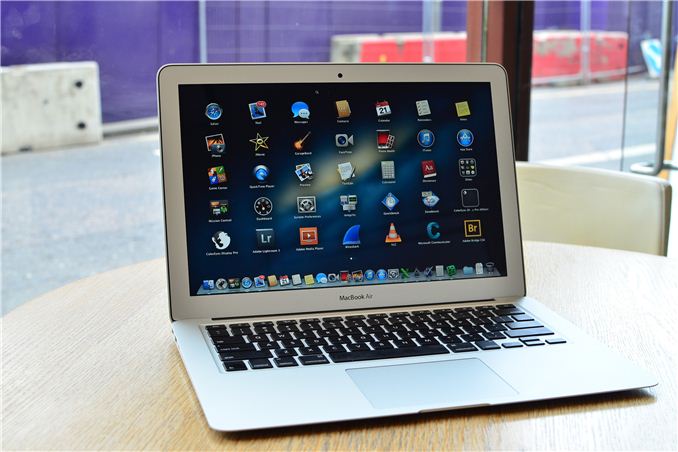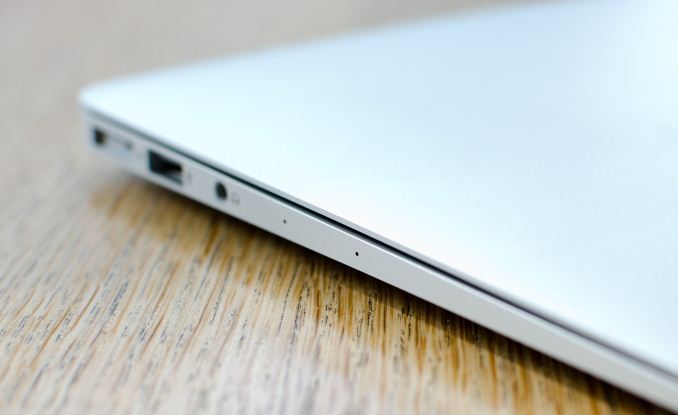The 2013 MacBook Air Review (13-inch)
by Anand Lal Shimpi on June 24, 2013 12:01 AM EST
Things didn’t go exactly as I’d expected at WWDC. I spent the week before the show at Computex, talking to PC OEMs, who had all just launched their Haswell ULT based Ultrabooks. With a couple of exceptions however, the bulk of Haswell ULT systems weren’t scheduled to ship until later this year. Even the Acer S7 I snagged while in Taipei was still a pre-production unit, with final hardware due out in the next month. Based on what I saw in Taiwan, and Intel having seeded me an Iris Pro machine the week before, I assumed that the MacBook Pro with Retina Display is what would get the Haswell treatment first. Obviously, that didn’t happen.
In hindsight, the move makes sense. Apple will sell far more MacBook Airs than rMBPs. The Apple/Intel relationship is looking very healthy these days, so it’s also not surprising that it would have supply and early enough access to Haswell ULT to launch the MBAs at WWDC with almost immediate availability. The Haswell ULT shift didn’t require a new chassis for Apple, which meant a less complex development process.
From the outside, the new MacBook Air looks nearly identical to its predecessor. There's a second mic opening on the left side of the machine now, but otherwise you'd be hard pressed to tell this year's model apart from the previous generation. Internally, nearly everything has changed.
The battery is higher capacity, with no increase in weight. Making better use of that larger battery is Intel's new Haswell ULT silicon. Since we're talking about a ULT part, the PCH moves from the motherboard to the CPU package - creating an emptier motherboard than we've seen in previous years:
The 2013 13-inch MacBook Air Motherboard, Courtesy iFixit
It's clear to me that the MBA is due for a more significant redesign, but this is not the year for that.
Alongside Haswell comes a brand new PCIe SSD, 802.11ac support and LPDDR3 memory. All at a price equal to, if not less than last year's models:
| 2013 MacBook Air Lineup | ||||||
| 11.6-inch | 11.6-inch (high-end) | 13.3-inch | 13.3-inch (high-end) | |||
| Dimensions |
H: 0.11-0.68" (0.3-1.7cm)
W: 11.8" (30cm) D: 7.56" (19.2cm) |
H: 0.11-0.68" (0.3-1.7cm)
W: 12.8" (32.5cm) D: 8.94" (22.7cm) |
||||
| Weight | 2.38 lbs (1.08kg) | 2.96 lbs (1.35kg) | ||||
| CPU | 1.3GHz dual-core Core i5 | 1.3GHz dual-core Core i5 | ||||
| GPU | Intel HD 5000 | |||||
| RAM | 4GB LPDDR3-1600 | |||||
| SSD | 128GB PCIe SSD | 256GB PCIe SSD | 128GB PCIe SSD | 256GB PCIe SSD | ||
| Display Resolution | 1366 x 768 | 1440 x 900 | ||||
| Ports | Thunderbolt, 2x USB 3.0, headphone jack | Thunderbolt, 2x USB 3.0, SD card slot, headphone jack | ||||
| Networking | 2x2:2 802.11ac | 2x2:2 802.11ac | ||||
| Battery | 38 Wh | 54 Wh | ||||
| Price | $999 | $1199 | $1099 | $1299 | ||
We've been over the MacBook Air chassis thoroughly in the past so I won't go through it again here. Build quality remains excellent. The clickpad and backlit keyboard never give me any troubles either. It's sad that we're still having clickpad issues elsewhere in ultraportables but this is one area where Apple's vertically integrated advantage is apparent (as is the company's willingness to spend a little extra on even the little details).
The only thing that hasn't changed, that perhaps should have is the display. The MacBook Air retains the same 1366 x 768/1440 x 900 panels from last year, while much of the competition has moved to at least 1080p IPS in the 13.3-inch form factor. This year at Computex we saw a number of systems move to 2560 x 1440 13.3-inch panels, at least as an option, however I'm expecting those systems to be priced more in line with the 13-inch rMBP rather than the MacBook Air. Admittedly, I don't know the right solution here.Ultra high resolution panels drive cost and power consumption up, the latter which can be offset by going to a larger battery - but then you have a 13-inch rMBP. Perhaps the right move for the MacBook Air would be for Apple to move to IPS panels at least? Or maybe we see a merger of the 13-inch MBA/rMBP, and something new entirely replace the 11-inch model.












233 Comments
View All Comments
sunman42 - Tuesday, June 25, 2013 - link
"Until OS X Mavericks arrives, you'll have to make sure to pay attention to things like background web browser tabs running Flash from killing your battery life." Or you could just do without Flash, or use Click to Flash, and avoid many very nasty bugs, constant security patches, and battery vampirism. Just, as they say, sayin'.jcbottorff - Tuesday, June 25, 2013 - link
The use of a 64K TCP window may be a feature not a bug. I say this because there often is a need to minimize latency of small packets, like used for Voip or other streaming media. With a TCP window size of 64K, on a 6 Mbps DSL connection, a packet queue of 64Kb takes about 85 milliseconds to drain. This means if you did a 64K TCP send (which optimally is one request to the NIC, with the NIC doing TCP segmentation), followed by a Voip UDP packet, it could be 85 milliseconds before the Voip packet goes out the DSL modem. If the TCP window were 256K, the latency would climb to 85*4=340 milliseconds, an unacceptable delay for Voip. It is possible to use varying TCP window sizes based on the current mix of network activity. Like for example, if you have a Voip call active and you have a TCP connection to a server on the Internet, over DSL modem, you may want to limit the TCP window size. If you only have a file sharing connection to a server on the local subnet, you can use a large window size. It's a lot more complex than just changing one number, unless you don't care about things like streaming media working correctly. OS designers often have to compromise, such that nobody is totally happy, but nobody is really upset either. I think the real question is how well the OS dynamically adjusts things under varying conditions to always give the most optimal user experience possible.SimonO101 - Tuesday, June 25, 2013 - link
Can we expect even greater battery life once OS X Mavericks comes online?darwinosx - Tuesday, July 9, 2013 - link
Yes. But if I said I knew this for sure I might be violating an NDA.trip1ex - Tuesday, June 25, 2013 - link
Also they should let you sync your MBA to a Mac/PC like an iOS device to help mitigate the 128gb storage in the base model. Or even let you sync to an external drive. I would love an elegant way to offload media particularly.darwinosx - Tuesday, July 9, 2013 - link
There are MANY ways to do this.niico - Tuesday, June 25, 2013 - link
I run Windows 8 in a Parallels VM on Mac OS 10.8 - this is my usual setup. If you're looking for a more strenuous battery test I suggest a VM. This often keeps the CPU at 30-50% even when both OS's are idle.It is an increasingly common use case - and many users would be interested to see the battery performance, specially on Haswell.
ctwise - Monday, July 1, 2013 - link
I run Windows 7 in VMWare Fusion on OS/X 10.8 as a SQL Server provider for development. I'm not sure if it's a difference between use cases for VMs or a Parallels vs. VMWare, but I rarely see even a single percentage of usage by my Windows VM.Oscarcharliezulu - Wednesday, June 26, 2013 - link
Good review, usual d$&khead comments from apple haters. I love hardware, all brands and watching it improve, it never gets old. Have recently switched to OSX on a 27" iMac at home for the fun of it and have to say now I'm familiar with it I prefer it to windows. Might switch my work laptop to a MBA, use it rather than my iPad+keyboard that I generally also carry around.akdj - Thursday, June 27, 2013 - link
Lol...exactly how it started for me...some 8 years ago now. Twenty years on PC (first computer was actually an Apple IIe)--& my wife was graduating with her masters degree. She'd been talking about a friend's MacBook for a few months...for her grad gift, I got her one of the old, plastic white MacBooks...my 8 year old son is still using that computer...in stock form daily!That first month...it was hard for me to give it up to her. I loved it. Loved OSx. Within six weeks I'd bought my own 15" MBP. Haven't bought a Windows machine since. For a couple years, I used bootcamp as there were a couple of programs that were only on Windows that I needed. They've since been ported to OSx and I've no need any longer for anything other than OSx
Kinda bums me out I waited as Long as I did. It's amazing having a house full of computers that NEVER need support!